Garlic mustard infestation
Image credit: Tessa Tormoen
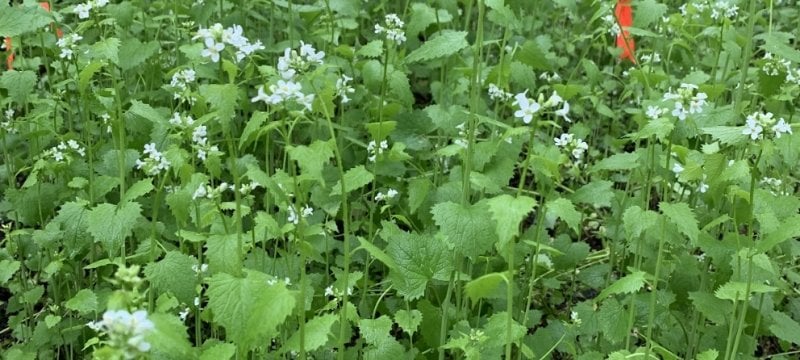
Garlic mustard infestation
Image credit: Tessa Tormoen
Garlic mustard, a biennial terrestrial herbaceous plant in the mustard family, Brassicaceae, is an understory invasive that is both sun- and shade-tolerant and can grow in a variety of habitats. Identifying characteristics of garlic mustard include:
Note: Another way to identify garlic mustard is by the distinct garlicky smell the leaves give off when crushed.
For more information, visit Midwest Invasive Species Information Network (MISIN).
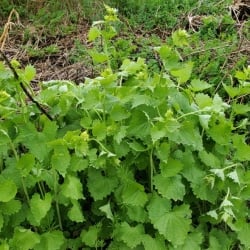
Garlic mustard plant
Image credit: Leslie J. Mehrhoff
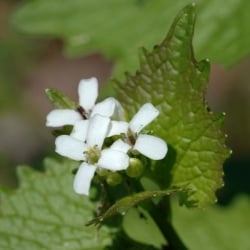
Garlic mustard flower
Image credit: Chris Evans
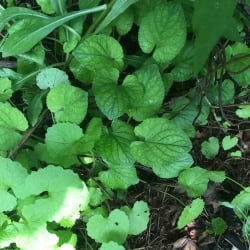
Garlic mustard rosette leaves (bottom left) along with native violet (top right) leaves
Image credit: Sigrid Resh
Garlic mustard is very difficult to get rid of after it has established in a habitat, but seasonal manual removal can be effective at preventing seed dispersal. For the best results when managing it, garlic mustard should be removed in the spring before any flower stalks or seeds can be produced.
Note: New research (Blossey et al. 2021) indicates that manual full plant removal may not be effective at preventing the spread of established garlic mustard populations. However, "Only if you find the first few individuals in an area that's far removed from the next garlic mustard infestation, would I still suggest you pull it out. That's okay. If you have a seed bank, you don't stand a chance." Below is an excerpt from one of KISMA's social media posts summarizing the work of Dr. Blossey.
"Whether you are familiar with garlic mustard (Alliaria petiolata) management or not, this is an invasive that you’ve likely heard of, and for a (not so) good reason. It is a major understory invader throughout the eastern and Midwest US, and it has been known to form dense monocultures. Traditional management usually consists of pulling and bagging vast amounts of the plant year after year. However, with the ability to produce a ten-year seed bank, these efforts are often futile and according to a new study led by Dr. Bernd Blossey (Cornell University), they may even hinder garlic mustard (GM) management.
At the end of their 15-year study, Blossey et al. (2021) concluded that GM invasion is the result of two pre-existing issues: the presence of earthworms and heavy deer browse. Nonnative to the upper peninsula, earthworms have reduced the soil litter layer and opened the door for many other invaders including garlic mustard. Deer can also act as a driver of further degradation by over-browsing native vegetation. In his study, Blossey had the unique ability to see changes in plant populations before and after deer populations were reduced from selected GM sites. Native vegetation rebounded even while GM populations also increased, so deer are the main impact on the native populations, not GM.
Next, the researchers made sure to emphasize that GM growth is directly related to local residence time. In other words, his data displayed that the older an infestation is, the less it is growing, and in fact, the more likely it is to be in decline.
This phenomenon was attributed to a negative soil feedback loop where after time, the plant alters the soil microbial community so much that the original site of invasion becomes less hospitable. Blossey uses the analogy of throwing a rock into a pond where the resulting ripples represent the spread of the invasive colony, while the center of the ripples eventually returns to normal."
Based on this study, KISMA will be scaling back on our manual management of garlic mustard in the Keweenaw to set up small-scale testing sites and begin our own follow-up research to see whether our data will follow the same trends as Blossey’s. Overall, this is noteworthy research that may greatly alter the way we approach garlic mustard management and invasive species management as a whole.
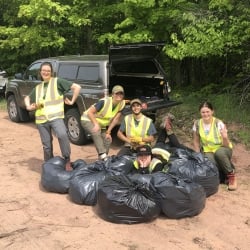
2020 KISMA crew with bags of pulled garlic mustard ready to be disposed
Image credit: Sigrid Resh
Species such as wild strawberry (Fragaria vesca) and wild ginger (Asarum canadense) are great native understory alternatives to garlic mustard. They are great food sources for wildlife and can discourage garlic mustard from spreading. Plants from the Dryopteridaceae family (ferns) are also great alternatives that can grow in disturbed areas and provide shelter and food for wildlife.